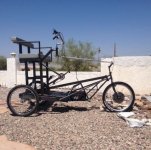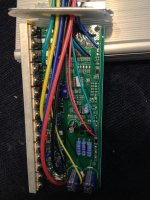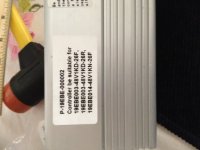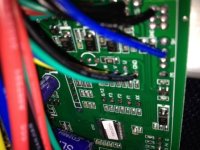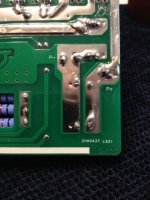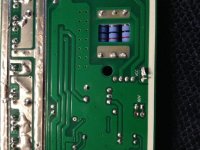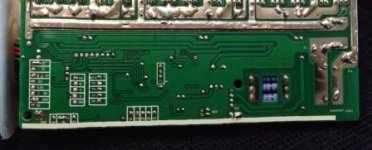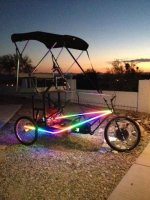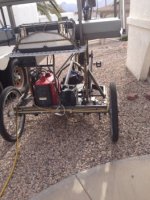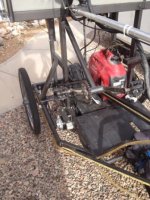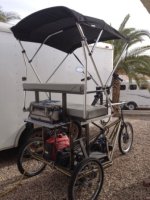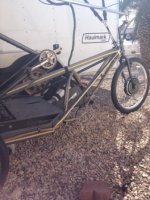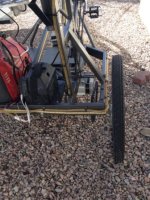Hank
1 mW
Here is my nearly complete cruiser e-trike. This e-trike was built to be ridden on the Playa (dry lake bed) at Burning Man, where the speed limit is 5 mph. The trike was constructed from a workman industrial trike, a Trek and a Giant mountain bike. I needed a wide track and long wheel base for stability, so I built a new frame section and reinforcement that resulted in a 4 foot wide, 8 foot long footprint. The seats are 4 feet above the ground, which puts the riders eye level about 7 feet above ground.
The rear wheels ride on 7/8” axles inside pillow blocks mounted to the 3” frame section. A coaster brake freewheel, transfers pedal power to one rear wheel. A caliper style brake is attached to the front. A 48 volt 750 watt BLDC hub motor provides power at the front forks. Two torque arms, one commercial, one I fabricated from ¼” steel plate, hold the front wheel in place and prevent the axle from spinning in the drop outs. The batteries are 4, 18ah SLA’s in a bag with the controller at mid-frame.
The trike was built to carry two riders, a Honda EU1000 generator, a Bimini top and about a thousand LEDS to light it up at night. The fully loaded capacity of the vehicle is about 875 pounds. The lower frame was fabricated from 1”x3” 18ga Rectangular steel tube; the superstructure uses 1”x2” 18ga Rectangular steel tube with additional frame reinforcement using 1” round steel tube. The seat was made with 3” thick dense foam from a boat upholstery shop. This is not a light weight; total empty weight without generator or riders is 230 pounds.
Stability given the height is very good, although it is obvious that it was not built to take fast turns or corner quickly. Testing it in our hilly neighborhood gave uphill speeds of about 10 mph with 18mph on flats. But bear in mind this trike will only see speeds no greater than 10 mph with 5 mph the general rule.
So I am looking for some advice. I want to add a reverse switch. I was thinking about using a 20 amp DPDT switch mounted near the handle bars to switch two phase wires of the hub motor. I would have to run 8 feet of 12ga wire to do so. The controller did not have an option for a reverse switch. I am a novice with electrical. Would you use a relay instead? Can anyone recommend a relay setup that I could use?
I also want to carry a 48 volt, 4 amp charger to plug into the generator to extend the range. I would like to charge while operating the trike. Does anyone know if this would present any problems? Thanks in advance for any advice you may have.
The rear wheels ride on 7/8” axles inside pillow blocks mounted to the 3” frame section. A coaster brake freewheel, transfers pedal power to one rear wheel. A caliper style brake is attached to the front. A 48 volt 750 watt BLDC hub motor provides power at the front forks. Two torque arms, one commercial, one I fabricated from ¼” steel plate, hold the front wheel in place and prevent the axle from spinning in the drop outs. The batteries are 4, 18ah SLA’s in a bag with the controller at mid-frame.
The trike was built to carry two riders, a Honda EU1000 generator, a Bimini top and about a thousand LEDS to light it up at night. The fully loaded capacity of the vehicle is about 875 pounds. The lower frame was fabricated from 1”x3” 18ga Rectangular steel tube; the superstructure uses 1”x2” 18ga Rectangular steel tube with additional frame reinforcement using 1” round steel tube. The seat was made with 3” thick dense foam from a boat upholstery shop. This is not a light weight; total empty weight without generator or riders is 230 pounds.
Stability given the height is very good, although it is obvious that it was not built to take fast turns or corner quickly. Testing it in our hilly neighborhood gave uphill speeds of about 10 mph with 18mph on flats. But bear in mind this trike will only see speeds no greater than 10 mph with 5 mph the general rule.
So I am looking for some advice. I want to add a reverse switch. I was thinking about using a 20 amp DPDT switch mounted near the handle bars to switch two phase wires of the hub motor. I would have to run 8 feet of 12ga wire to do so. The controller did not have an option for a reverse switch. I am a novice with electrical. Would you use a relay instead? Can anyone recommend a relay setup that I could use?
I also want to carry a 48 volt, 4 amp charger to plug into the generator to extend the range. I would like to charge while operating the trike. Does anyone know if this would present any problems? Thanks in advance for any advice you may have.


